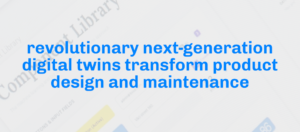In the rapidly evolving landscape of Industry 4.0, the concept of digital twins has emerged as a transformative force, reshaping the way we design, produce, and manage assets. However, what many may not realize is that not all digital twins are created equal. There are two distinctive types: those born from existing entities and those crafted even before the physical counterpart exists.
Let’s delve into the fascinating realm of these dual-natured digital twins.
The Commonly Known Post-Existing Digital Twins: A Mirror to Reality
The first type of digital twin is what we commonly encounter in various industries today. It’s a reflection, a virtual counterpart that comes into existence after a product, device, or asset is already in operation. This digital twin is crafted through the meticulous collection and processing of data derived from the real-world counterpart.
How it Works:
- Data Collection: Sensors and other data-collecting devices embedded in the physical asset continuously gather information on its performance, behavior, and surroundings.
- Processing and Visualization: The collected data is then processed through advanced analytics, AI algorithms, and other tools to create a virtual representation of the asset. This representation is visualized in a digital format, providing a real-time snapshot of the asset’s status.
- Monitoring and Optimization: Post-existing digital twins are invaluable for monitoring the health and performance of assets. They enable predictive maintenance, optimization of operations, and a deeper understanding of how the physical entity behaves in various conditions.
The Next-Gen Pre-Manufacture Digital Twins: A Blueprint for Innovation
In contrast, pre-manufacture digital twins are conceived even before the physical entity takes its first form. This type of digital twin is born during the service design and planning stages, serving as a blueprint for the creation of the actual product, device, or asset.
How it Works:
- Service Design Phase: Before any physical manufacturing begins, a digital twin is created. It all begins with a service design process wherein companies are to clearly define and map out the product and its service components, both from business and technology perspective. Digital twins allow for these value-adding service components and even the complete transformation from products to services.
- Collaboration and Iteration: Pre-manufacture digital twins facilitate collaboration among cross-functional teams. Engineers, designers, and other stakeholders can iterate on the virtual model, making adjustments to improve efficiency, reduce costs, or enhance performance.
- Minimum Viable Product Launch: After the service design phase, rather than working with prototypes, it is possible to create minimum viable products right away that are ready for launch. As the digital twins keeps providing usage and environment data all the time, the product can be optimized continuously.
- Simulation and Analysis: These traditional digital twin processes are performed even before the product comes into existence, and continue throughout it’s lifecycle.
- Whole Lifecycle Tracking: The utility of pre-manufacture digital twins extends beyond the product’s birth, offering comprehensive lifecycle tracking. From inception to end-of-life, these digital twins provide continuous insights, facilitating ongoing optimization, maintenance, and even sustainable disposal practices.
Read more about Digital Twins.




